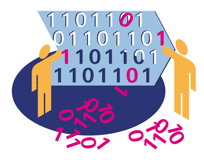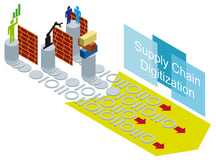5 Keys to Supply Chain Resilience in 2021
Brian Hoey - December 26, 2020

 Let’s try a little thought experiment: if you set out to measure the resilience of your supply chain, what KPIs would you be looking at? At the highest level, you might be interested in on-time delivery rates and order accuracy—since an upward trend on these metrics would prove that you were getting the job done even under changing conditions. But at another layer below that, you might look at the rate of short-term planning changes over time—after all, if your plans constantly required last-minute alterations in order to keep order fulfillment on track, that might suggest a baseline level of volatility that cuts against true resilience.
Let’s try a little thought experiment: if you set out to measure the resilience of your supply chain, what KPIs would you be looking at? At the highest level, you might be interested in on-time delivery rates and order accuracy—since an upward trend on these metrics would prove that you were getting the job done even under changing conditions. But at another layer below that, you might look at the rate of short-term planning changes over time—after all, if your plans constantly required last-minute alterations in order to keep order fulfillment on track, that might suggest a baseline level of volatility that cuts against true resilience.
While order performance metrics might tell you more about the outcomes of your production runs, KPIs that actually track the stability of your plans, forecasts, models, and more can give you a sense of what’s going on beneath the hood. And, more importantly, they can help you target areas for investment and improvement: if can you can pinpoint your demand forecasts as an area of volatility (i.e. they don’t reflect upcoming demand effectively, meaning that your demand-capacity plans are subject to disruption), you can take measured steps to improve those forecasts and thereby reduce disruptions.
This is the obvious approach to increasing resilience in a nutshell. But what are the most common steps that supply chain businesses need to take to reduce volatility and truly become more resilient?
1. Digitization
We’ll discuss a number of different technologies over the course of this piece, but all of them are fundamentally going to fall under the heading of this first key to supply chain resilience: digitization. Serious digital transformation efforts are the only way to lay the groundwork for the planning paradigm shifts and business process integrations that will carry your supply chain into the era of Industry 4.0 and Logistics 4.0. The era of the Excel spreadsheet is over—and the era of connectivity and interoperability by way of digital planning, scheduling, sequencing, and execution systems needs to take its place. As we dive deeper into the individual technologies that will power your resilience in an increasingly complex and competitive supply chain environment, it’s crucial to keep digitization efforts top of mind.
2. AI/ML
One of the reasons that digitization is so crucial to building out smarter and more resilient business processes is that digital transformation is the only way to collect and store enough data to power AI (artificial intelligence) and ML (machine learning) workflows. Indeed, these technologies depend on rapid flows of large quantities of data. In turn, these rapid data flows can be leveraged into rapid calculations that can bring you closer to real-time planning. ML, in particular, by finding hidden correlations between different factors (lead times, inventory levels, throughput data, etc.), can help you to improve forecasts across virtually all supply chain touchpoints, which you can then leverage into process improvements. Thus, you can directly improve your demand forecasts based on (but not limited by) historical data, and thus increase resiliency right off the bat. You can also forecast machine breakdowns and proactively schedule idle time for maintenance in such a way as to minimize disruptions.
3. Digital Twins
In addition to powering improved data analysis, to the end of smarter forecasts and more optimized planning flows, AI and ML can also improve the quality of your digital supply chain twins (i.e. digital simulations of your end-to-end supply chain). By making these simulations as lifelike as possible and updating them constantly to reflect the real-life conditions of your supply chain, you can create both a space for collaboration in planning and a structure that can act as a single source of truth. Digital twins aren’t particularly new or particularly niche technology, but the more complex the modern supply chain becomes, the more important it is to create simulations that can model not just an individual production plant or a particular shipping route, but the entire value chain. This is a tall order from a technology perspective—insofar as it requires serious digitization and integration efforts—but the result is that you can proactively model different strategies for increasing resilience and use your simulations to identify the best possible versions of your own value stream.
4. CORE Planning
Of course, in order for the digital technologies we’ve discussed above to provide real value, you need a way to incorporate the insights you glean from them into a cohesive, integrated planning process that goes beyond siloized strategic, tactical, and operational planning flows. This integrated method of planning is referred to by Gartner as the CORE Planning method—and it reflects the fact that different planning layers are actually all parts of the same whole and thus need to be treated as such. Production plans, demand-capacity plans, S&OP, S&OE (sales and operation execution), and more all have to be created in full visibility of the others within a transactional system that ensures that each planning environment always reflects the most up-to-date possible information. In this way, set yourself up to bridge the gaps between planning in the abstract and supply chain execution in real-life circumstances that ultimately defines resilient supply chains. In the COVID-19 era, a CORE Planning model would give you the ability to identify a disconnect between planned production programs and inventory plans as both of them evolve, in order to stave off the kinds of outages that we saw so frequently in the early months of the pandemic.
5. Cloud Technology
Finally, we get to the technology that lays the connected, digital, scalable foundation for the cohesive processes we’ve been discussing: the cloud. Where on-premise technology deployments are relatively inflexible and don’t offer much in the way of easy networking and scaling opportunities, the cloud is by nature distributed and connected, and it promotes visibility and interoperability. This empowers you to connect your digital technology without worrying about geographical boundaries—meaning that you can break down silos and speed up technology adoption, resulting in reduced susceptibility to disruptions. As a result of these features, the cloud makes it possible to roll out new features to plants 200x more quickly than previously, power lean-out software architecture with cost reductions of up to 40x over normal operations, and to roll out entire new applications 50x faster. The result is that now matter how quickly the global supply chain changes, you can change and adapt even more rapidly.
LATEST POSTS
- Understand Why Production Planning Needs Specialized Solutions
- Understand Circular Economy in The Manufacturing Industry
- How Can Industry 4.0 IT Integration Be Achieved Smoothly?
- The Significance of Order Sequencing in Discrete Manufacturing
- How to improve your Supply Chain Management: The Power of Control Towers



